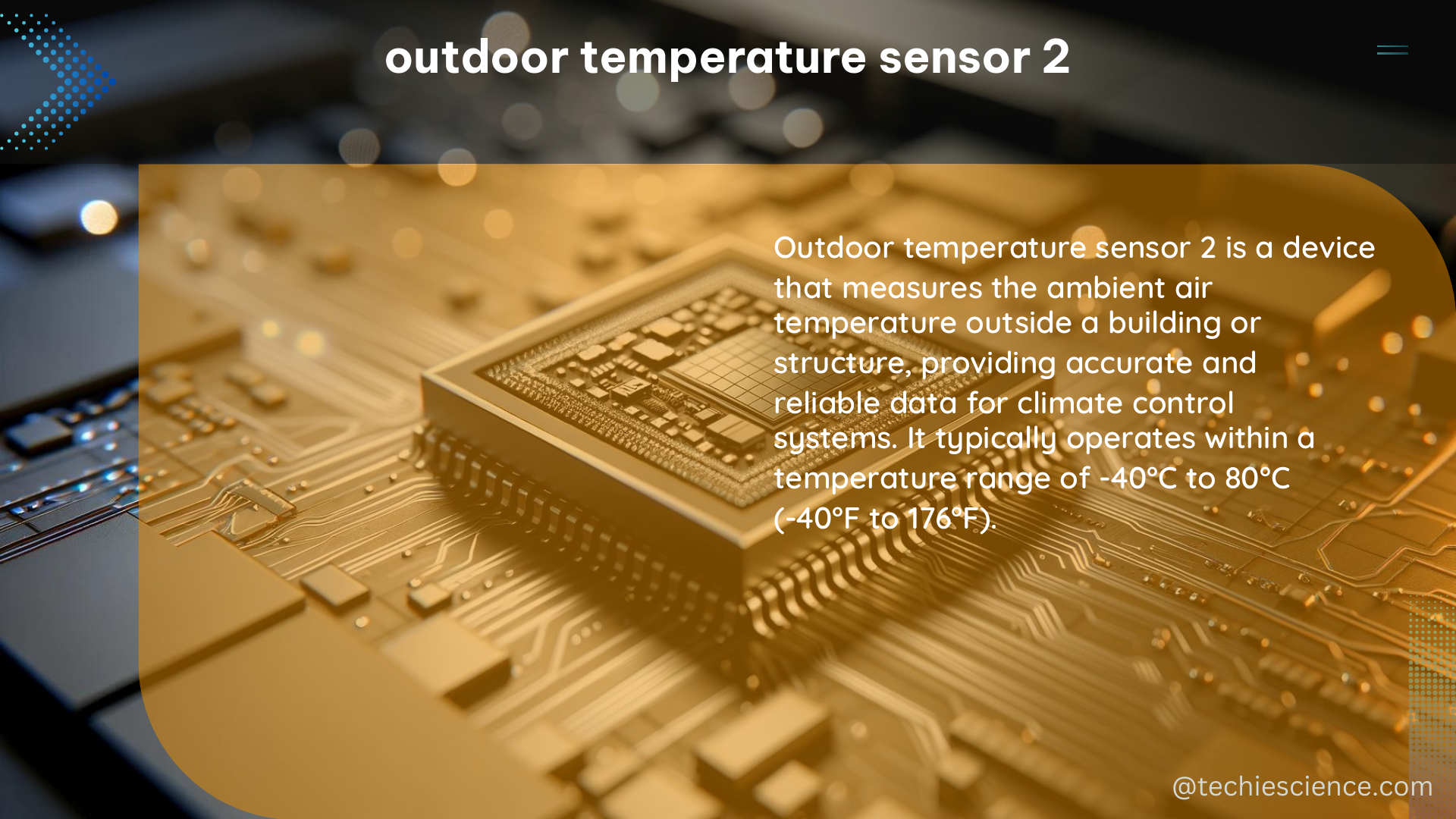The outdoor temperature sensor 2 is a crucial device for accurately measuring the temperature in the outdoor environment. This sensor plays a vital role in various applications, from home automation and HVAC systems to weather monitoring and climate research. Understanding the technical aspects of this sensor is essential for ensuring its optimal performance and reliability.
Sensor Response Time and Time Constant
The sensor response time is the time it takes for the sensor reading to reach 99.3% of the total step change in the measured parameter, in this case, the new temperature. The sensor time constant, represented by the Greek letter τ (tau), is the time required for the sensor reading or output to reach 63.2% of its total step change in the measured parameter.
For example, if a temperature sensor is taken out of an ice bath at 0°C and placed in a room at 10°C, it will take exactly one time constant (τ) to reach 6.32°C, and five time constants to reach 99.3% of the 10°C step change in temperature.
The sensor response time and time constant are influenced by several factors, including:
- Type of Media Measured: The physical properties of the media being measured, such as its thermal conductivity and heat capacity, can affect the sensor’s response time and time constant.
- Flow Rate of Media: The flow rate of the media being measured can also impact the sensor’s response time and time constant. Faster flow rates generally result in shorter response times.
- Emissivity of Sensor Materials: The emissivity of the materials used in the sensor’s construction can affect its response to changes in radiant heat, which is particularly important for outdoor temperature measurements.
Meteorological Air Temperature Measurement

When measuring air temperature for meteorological applications, solar radiation shields are often used to limit the amount of error caused by the sun’s irradiated heat onto the sensor. This irradiated heat can come in the form of diffuse radiation (scattered by the atmosphere) or reflected radiation (from the surrounding environment).
The use of solar radiation shields helps to ensure that the sensor is measuring the true air temperature, rather than being influenced by the sun’s radiant energy. This is crucial for accurate weather monitoring and climate data collection.
Practical Accuracy Considerations
In terms of practical accuracy, the sensor response time is typically taken as the time it takes for the sensor to reach 99.3% of the measured temperature change. This is because it is generally accepted that a sensor has reached its final reading when it has reached 99.3% of the total step change.
Example: YoLink LoRa Temperature Sensor
One example of an outdoor temperature sensor 2 is the YoLink LoRa temperature sensor with a probe. This sensor has the following key features:
- Waterproof Design: The sensor is designed to be truly waterproof, making it suitable for outdoor use in various weather conditions.
- Long Range: The YoLink LoRa technology provides an extremely long range, allowing the sensor to communicate with the YoLink hub over a distance of up to 1/2 mile (800 meters) in open areas.
- Home Assistant Integration: The YoLink temperature sensor can be integrated with Home Assistant, a popular open-source home automation platform, enabling seamless integration with various smart home systems.
- Alexa Skill: The sensor also has an Alexa skill, allowing users to easily monitor and control the temperature using voice commands.
Conclusion
The outdoor temperature sensor 2 is a critical component in various applications, from home automation to weather monitoring. Understanding the technical aspects of this sensor, such as its response time, time constant, and factors affecting its accuracy, is essential for ensuring its optimal performance and reliability. By leveraging the capabilities of advanced sensors like the YoLink LoRa temperature sensor, users can enjoy accurate and reliable outdoor temperature monitoring, seamlessly integrated with their smart home and automation systems.
References:
- Barani Design. (2019, May 7). Difference between sensor response time and sensor time constant. Retrieved from https://www.baranidesign.com/faq-articles/2019/5/6/difference-between-sensor-response-time-and-sensor-time-constant-tau
- Reddit. (2022, September 27). Outdoor temperature sensor. Retrieved from https://www.reddit.com/r/homeassistant/comments/xpuno1/outdoor_temperature_sensor/
- HVAC-Talk. (2006, June 29). Infinity Stat Outdoor Sensor Error. Retrieved from https://hvac-talk.com/vbb/threads/108719-Infinity-Stat-Outdoor-Sensor-Error
- The Cave Pearl Project. (2016, February 12). Triage step for cheap DS18b20 temperature sensors. Retrieved from https://thecavepearlproject.org/2016/02/12/triage-step-for-cheap-ds18b20-temperature-sensors/
- YouTube. (2022, November 1). Apple Watch 8: Using the New Temperature Sensor. Retrieved from https://www.youtube.com/watch?v=iyW5x04HJ9I

The lambdageeks.com Core SME Team is a group of experienced subject matter experts from diverse scientific and technical fields including Physics, Chemistry, Technology,Electronics & Electrical Engineering, Automotive, Mechanical Engineering. Our team collaborates to create high-quality, well-researched articles on a wide range of science and technology topics for the lambdageeks.com website.
All Our Senior SME are having more than 7 Years of experience in the respective fields . They are either Working Industry Professionals or assocaited With different Universities. Refer Our Authors Page to get to know About our Core SMEs.